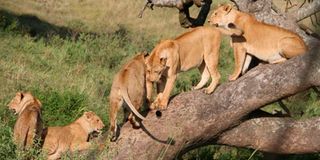A day with the Maasai Mara manes and big cats

A day with the Maasai Mara manes and big cats. Photo | Pool
What you need to know:
- The Mara is without doubt ‘big cat’ country
- In the first light of the day, as sun splatters the horizon in gold and orange, a huge male with a full mane of black, is frozen in space in the midst of the rising mist
“That’s Bella 2,” states Milton Karienkei, our driver-guide from Mara Ngenche, the little luxury camp where the Talek meets the Mara River. Bella 2 is lounging high up on her tree, legs dangling, her roseate-spotted coat patterned in the green foliage. Bella 2 also has her prey up there with her, as is typical of a leopard. It’s an antelope of some sort. Through the binoculars we can see its legs dangling from the branch.
Bella 2 is the daughter of Bahati, who in turn is the granddaughter of Bella (the original). Bahati features in Jonathan and Angela Scott's latest TV series Big Cat Tales aired on Animal Planet. The series focuses on the Maasai Mara's iconic big cats and is co-hosted by Jackson ole Looseyia, the Maasai presenter on the BBC show, Big Cat Live. The Scott’s need no introduction for millions know them from Big Cat Diary, which aired from 1996 to 2002, documenting the real-life stories of the March lions in the iconic reserve.
After many minutes, Bella 2 stretches and climbs down the tree. It’s close to getting dark and she strides into the bushes and vanishes. Known to be one of the most elusive big cats, she’s given what every visitor to the Mara wants – a chance to see a leopard in the wild.
We meet Bella 2 again the following evening. Her stomach is heavy. The guides are convinced she is soon to be a mother.
The Mara is without doubt ‘big cat’ country. In the first light of the day, as sun splatters the horizon in gold and orange, a huge male with a full mane of black, is frozen in space in the midst of the rising mist. Everyone is still, with abated breath. A few feet from the lion is a Spotted hyena who seems oblivious of the King of the jungle.
The lion has made a kill. The hyena is lurking around to steal a bite. As the daring hyena dashes forward, the lion springs into action and chases it away.
Driving further into the savannah grassland, tawny lionesses lead their cubs to the bushes to keep them safe from the sun and predators. We end the early morning game drive with a cheetah mama and her twin cubs drinking from a puddle on the road. The Mara has the highest density of cheetahs per square kilometre.
In less than 48 hours in the Mara, her three big cats have regaled us with an epic real life episode.
Later, Dr Elena Chelysheva founder of the Mara-Meru Cheetah Projectaccompanies us on a game drive when we see Bella 2 again, this time seated on a termite mound. In 2000, Elena was invited by the Kenya Wildlife Service to work as assistant researcher at Maasai-Mara Cheetah Conservation Project because of her work with the cats.
Her latest project is collecting cheetah poop to trace the genetic lineage of cheetahs, that can trace who the father is. The females stay with the cubs and so it’s easy to know who the mother is. Already the team has identified many of Mara’s cheetahs from the photos which traces generations of the Mara Cheetah pedigree. The project has expanded to Meru National Park where Joy Adamson took Pippa the cheetah in the 1970s to return her to the wild when her owners were leaving the country. Pippa who is buried in the park, had cubs. I wonder if the genetic work being done by the MMCP might one day trace Pippa the spotted sphinx’s descendants.
There’s never a dull moment in the Mara.
In the darkness driving to catch the balloon ride over the Mara, a lion with its magnificent mane is caught in the head lights. He gives a lazy look and returns to snooze.
While lion prides are territorial with the females raising their cubs and keeping the pride together, the young males will leave the pride to establish their own pride.
Reading through the Mara Predator Conservation Programme, it’s these young males who come into direct contact with people and livestock which leads to conflict when the lion attacks. The programme now has young lions wearing satellite collars to help alert the team to warn the herders before the attack happens.
It’s these wandering young males who are spreading the healthy gene flow which is so important to avoid in-breeding.
Be a Citizen Scientist
When on safari in the Mara, send your pictures of the lions and cheetahs to the researchers which helps them keep tag of their subjects.
Fly or drive to the Mara. Remember, you are a visitor, give the cats and all other wild animals their space. A good pair of binoculars is great. It stops people from crowding around the cats and stressing them – just like us.
For feedback to the editor email [email protected]




